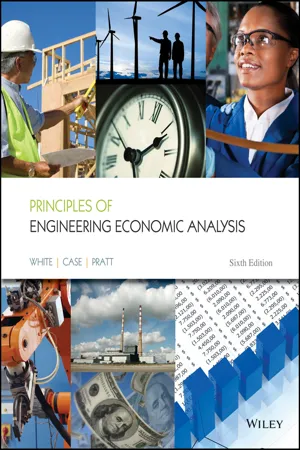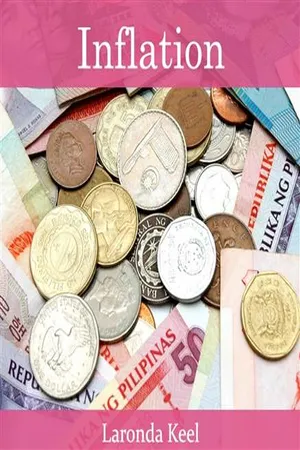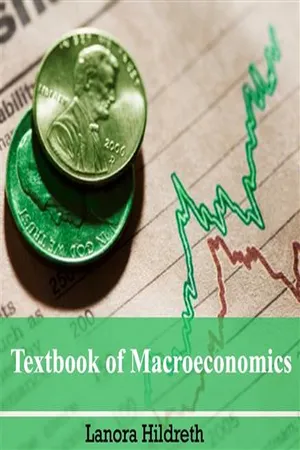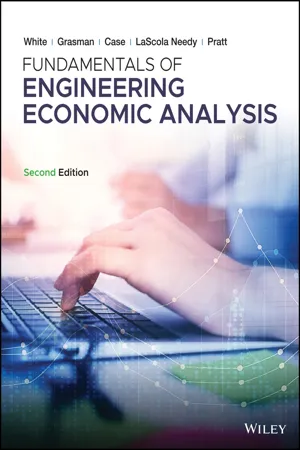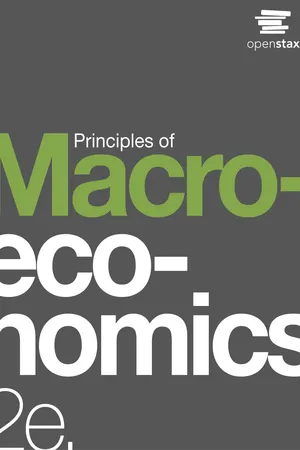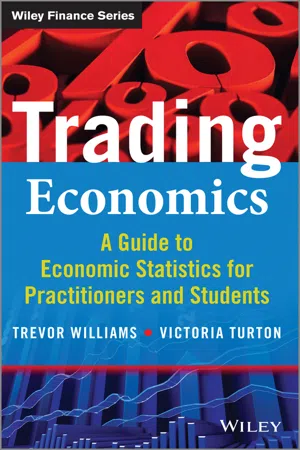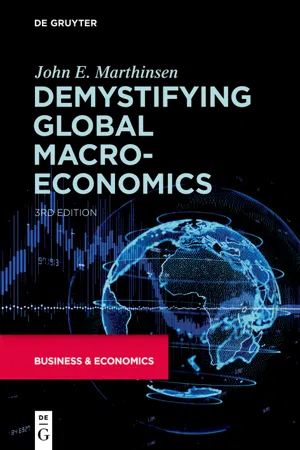Business
Inflation and Business
Inflation refers to the general increase in prices of goods and services in an economy over a period of time. In the context of business, inflation can impact costs, pricing strategies, and consumer purchasing power. Businesses may need to adjust their pricing, wages, and investment decisions to mitigate the effects of inflation on their operations and profitability.
Written by Perlego with AI-assistance
Related key terms
1 of 5
8 Key excerpts on "Inflation and Business"
- eBook - PDF
- John A. White, Kenneth E. Case, David B. Pratt(Authors)
- 2012(Publication Date)
- Wiley(Publisher)
First, it presents the definition of inflation in Webster’s New Universal Unabridged Dictionary published in 1983: ‘‘An increase in the amount of currency in circulation, resulting in a relatively sharp and sudden fall in its value and rise in prices; it may be caused by an increase in the volume of paper money issued or of gold mined, or a relative increase in expenditures as when the supply of goods fails to meet the demand.’’ Next, it provides the definition in Houghton Mifflin’s fourth edition of The American Heritage Dictio- nary of the English Language: ‘‘A persistent increase in the level of consumer prices or a persistent decline in the purchasing power of money, caused by an increase in available currency and credit beyond the proportion of available goods and services.’’ Then, InflationData.com concludes, ‘‘So between 1983 and 2000 the definition appears to have shifted from the cause to the result. Also, note that the cause could be either an increase in money supply or a decrease in available goods and services.’’ Although general agreement regarding the definition of inflation does not exist, consumers understand the impact of inflation on their ability to purchase goods and services. As the value of a dollar diminishes over time, the effects of inflation are manifested. In summary, inflation is characterized by a decrease in the purchasing power of money that is caused by an increase in general price levels of goods and services without an accompanying increase in the value of the goods and services. As noted above, inflationary pressure is created when more dollars are put into an economy without an accompanying increase in goods and services. In other words, printing more money without an increase in economic output generates inflation. Inflation can have such a significant impact on an investment’s economic worth that it should be considered when comparing investment alternatives. - No longer available |Learn more
- (Author)
- 2014(Publication Date)
- Orange Apple(Publisher)
____________________ WORLD TECHNOLOGIES ____________________ Chapter- 1 Inflation In economics, inflation is a rise in the general level of prices of goods and services in an economy over a period of time. When the general price level rises, each unit of currency buys fewer goods and services. Consequently, inflation also reflects an erosion in the purchasing power of money – a loss of real value in the internal medium of exchange and unit of account in the economy. A chief measure of price inflation is the inflation rate, the annualized percentage change in a general price index (normally the Consumer Price Index) over time. Inflation's effects on an economy are various and can be simultaneously positive and negative. Negative effects of inflation include a decrease in the real value of money and other monetary items over time, uncertainty over future inflation may discourage investment and savings, and high inflation may lead to shortages of goods if consumers begin hoarding out of concern that prices will increase in the future. Positive effects include ensuring central banks can adjust nominal interest rates (intended to mitigate recessions), and encouraging investment in non-monetary capital projects. Economists generally agree that high rates of inflation and hyperinflation are caused by an excessive growth of the money supply. Views on which factors determine low to moderate rates of inflation are more varied. Low or moderate inflation may be attributed to fluctuations in real demand for goods and services, or changes in available supplies such as during scarcities, as well as to growth in the money supply. However, the consensus view is that a long sustained period of inflation is caused by money supply growing faster than the rate of economic growth. Today, most mainstream economists favor a low steady rate of inflation. - No longer available |Learn more
- (Author)
- 2014(Publication Date)
- White Word Publications(Publisher)
____________________ WORLD TECHNOLOGIES ____________________ Chapter-7 Inflation In economics, inflation is a rise in the general level of prices of goods and services in an economy over a period of time. When the general price level rises, each unit of currency buys fewer goods and services. Consequently, inflation also reflects an erosion in the purchasing power of money – a loss of real value in the internal medium of exchange and unit of account in the economy. A chief measure of price inflation is the inflation rate, the annualized percentage change in a general price index (normally the Consumer Price Index) over time. Inflation's effects on an economy are various and can be simultaneously positive and negative. Negative effects of inflation include a decrease in the real value of money and other monetary items over time, uncertainty over future inflation may discourage investment and savings, and high inflation may lead to shortages of goods if consumers begin hoarding out of concern that prices will increase in the future. Positive effects include ensuring central banks can adjust nominal interest rates (intended to mitigate recessions), and encouraging investment in non-monetary capital projects. Economists generally agree that high rates of inflation and hyperinflation are caused by an excessive growth of the money supply. Views on which factors determine low to moderate rates of inflation are more varied. Low or moderate inflation may be attributed to fluctuations in real demand for goods and services, or changes in available supplies such as during scarcities, as well as to growth in the money supply. However, the consensus view is that a long sustained period of inflation is caused by money supply growing faster than the rate of economic growth. Today, most mainstream economists favor a low, steady rate of inflation. - eBook - PDF
- Steven A. Greenlaw, Timothy Taylor(Authors)
- 2014(Publication Date)
- Openstax(Publisher)
Inflation, on the other hand, means that there is pressure for prices to rise in most markets in the economy. In addition, price increases in the supply-and-demand model were one-time events, representing a shift from a previous equilibrium to a new one. Inflation implies an ongoing rise in prices. If inflation happened for one year and then stopped—well, then it would not be inflation any more. This chapter begins by showing how to combine prices of individual goods and services to create a measure of overall inflation. It discusses the historical and recent experience of inflation, both in the United States and in other countries around the world. Other chapters have sometimes included a note under an exhibit or a parenthetical reminder in the text saying that the numbers have been adjusted for inflation. In this chapter, it is time to show how to use inflation statistics to adjust other economic variables, so that you can tell how much of, say, the rise in GDP over different periods of time can be attributed to an actual increase in the production of goods and services and how much should be attributed to the fact that prices for most things have risen. Inflation has consequences for people and firms throughout the economy, in their roles as lenders and borrowers, wage-earners, taxpayers, and consumers. The chapter concludes with a discussion of some imperfections and biases in the inflation statistics, and a preview of policies for fighting inflation that will be discussed in other chapters. 9.1 | Tracking Inflation By the end of this section, you will be able to: • Calculate the annual rate of inflation • Explain and use index numbers and base years when simplifying the total quantity spent over a year for products • Calculate inflation rates using index numbers Dinner table conversations where you might have heard about inflation usually entail reminiscing about when “everything seemed to cost so much less. - John A. White, Kellie S. Grasman, Kenneth E. Case, Kim LaScola Needy, David B. Pratt(Authors)
- 2020(Publication Date)
- Wiley(Publisher)
In this chapter, we examine the before-tax and after-tax effects of inflation on the eco- nomic worth of an investment when capital is borrowed and when it comes from retained earnings. We show that inflation can significantly impact the economic viability of a capital investment. For that reason, when comparing investment alternatives in an inflationary economy, it is important to give explicit consideration to inflation. 3. Inflation rates in the United States have been fairly steady in recent years. Does Caterpillar need to develop different business strategies for its ventures within and outside the United States? 4. The inflation rate in different regions of the world is outside Caterpillar’s control. What can the com- pany do to protect itself from the adverse effects of inflation, such as rising commodity or component prices and rising labor rates? 10.1 The Meaning and Measure of Inflation LEARNING OBJECTIVE Quantify the effects of inflation on purchasing power with the inflation rate. Consumers understand the impact of inflation on their ability to purchase goods and services. As the value of a dollar diminishes over time, the effects of inflation are mani- fested. More precisely, we can say that inflation is a decrease in the purchasing power of money that is caused by an increase in general price levels of goods and services without an accompanying increase in the value of the goods and services. Inflationary pressure is created when more dollars are put into an economy without an accompanying increase in Inflation A decrease in the purchasing power of money that is caused by an increase in general price levels of goods and services without an accompanying increase in the value of the goods and services. Systematic Economic Analysis Technique 1. Identify the investment alternatives 2. Define the planning horizon 3. Specify the discount rate 4. Estimate the cash flows 5. Compare the alternatives 6.- eBook - PDF
- Steven A. Greenlaw, Timothy Taylor, David Shapiro(Authors)
- 2017(Publication Date)
- Openstax(Publisher)
A relative price change occurs when you see that the price of tuition has risen, but the price of laptops has fallen. Inflation, on the other hand, means that there is pressure for prices to rise in most markets in the economy. In addition, price increases in the supply-and-demand model were one-time events, representing a shift from a previous equilibrium to a new one. Inflation implies an ongoing rise in prices. If inflation happened for one year and then stopped, then it would not be inflation any more. This chapter begins by showing how to combine prices of individual goods and services to create a measure of overall inflation. It discusses the historical and recent experience of inflation, both in the United States and in other countries around the world. Other chapters have sometimes included a note under an exhibit or a parenthetical reminder in the text saying that the numbers have been adjusted for inflation. In this chapter, it is time to show how to use inflation statistics to adjust other economic variables, so that you can tell how much of, for example, we can attribute the rise in GDP over different periods of time to an actual increase in the production of goods and services and how much we should attribute to the fact that prices for most items have risen. Inflation has consequences for people and firms throughout the economy, in their roles as lenders and borrowers, wage-earners, taxpayers, and consumers. The chapter concludes with a discussion of some imperfections and biases in the inflation statistics, and a preview of policies for fighting inflation that we will discuss in other chapters. - eBook - PDF
Trading Economics
A Guide to Economic Statistics for Practitioners and Students
- Trevor Williams, Victoria Turton(Authors)
- 2014(Publication Date)
- Wiley(Publisher)
4 Inflation Inflation is always and everywhere a monetary phenomenon in the sense that it is and can be produced only by a more rapid increase in the quantity of money than in output. Milton Friedman 1 WHAT IS INFLATION? Inflation tells us the changing (increasing) price of a range of goods or services; basically how much of something we can get for our money. The rate of change of prices – the speed at which the price of goods and services that are bought by households or businesses alter – is called inflation. But prices can also fall, in a process called deflation, sometimes termed negative inflation. Inflation is more common than deflation, or at least it has been in the last 50 years or so, and so it has become associated with changes in the price of goods and services. Historically, however, price falls were as common as price rises, as we will see later. Both inflation and deflation have advantages and disadvantages, which we will explore in more detail later in this chapter. THE HISTORY OF INFLATION Inflation has been around for a long time, but, as Figure 4.1 shows, the level of prices (the index) really only rose consistently and sharply in the UK from the 1970s onwards. This was after the US came off the gold standards and the Bretton Woods system of fixed exchange rates, which had prevailed after the Second World War, ended. Money was now backed by government fiat and trust rather than by gold. And exchange rates were no longer fixed but allowed to float freely. This seems to have led to a rapid rise in the level of prices or, in other words, to the Retail Prices Index. Before that, for hundreds of years, the level 1 Friedman, M., The Counter-Revolution in Monetary Theory (1970). 100 Trading Economics Retail Price Index (1987 = 100) 0 10 20 30 40 50 60 70 80 90 100 1264 1296 1328 1360 1392 1424 1456 1488 1520 1552 1584 1616 1648 1680 1712 1744 1776 1808 1840 1872 1904 1936 1968 2000 Figure 4.1 Price index over time. - eBook - PDF
- John E. Marthinsen(Author)
- 2020(Publication Date)
- De Gruyter(Publisher)
Chapter 4 Inflation and Real GDP “ Where ’ s the beef? ” 1 This is the question business managers should be asking themselves as they prepare their short-term budgets and business plans. The “ beef ” for any business comes from increasing the quantity of goods and serv-ices sold to customers, reducing real (inflation-adjusted) costs of production, and earning real profits from sound and timely investment decisions. Like the distorted reflections, we see of ourselves in carnival mirrors, infla-tion twists the image of both business performance and the economic world around us. For this reason, managers should understand what inflation is and how to remove its contorting effects from their analyses. Only in this way can they get a clear view of economic reality. This chapter explains inflation, how it is measured, what it measures, and, equally important, what it does not measure. The chapter goes on to explain how the illusionary effects of inflation can be removed from national income statistics, such as gross domestic product (GDP) so that a nation ’ s past, current, and expected future economic growth rates come into clearer view. The Basics What Is Inflation? In 1917, before the hazards of smoking were so well known, Vice President Thomas R. Marshall said on the floor of the U.S. Senate, “ What this country needs is a good five-cent cigar. ” About a decade and a half later, Marshall ’ s quip was revised by New York journalist Franklin P. Adams, who said, “ There are plenty of good five-cent cigars in the country. The trouble is they cost a quarter. What this country needs is a good five-cent nickel. ” Inflation is like an acid that erodes the purchasing power of a nation ’ s cur-rency. The higher the inflation, the greater the erosion. Consider the U.S. dollar ’ s loss of purchasing power between 1913 and 2019.
Index pages curate the most relevant extracts from our library of academic textbooks. They’ve been created using an in-house natural language model (NLM), each adding context and meaning to key research topics.
